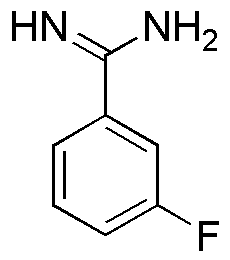3-Fluoro-benzamidine is widely utilized in research focused on:
- Pharmaceutical Development: This compound serves as a key intermediate in the synthesis of various pharmaceuticals, particularly those targeting specific enzymes and receptors, enhancing drug efficacy.
- Biochemical Research: It is used in studies involving proteases and other enzymes, helping researchers understand enzyme mechanisms and develop inhibitors that can lead to new therapeutic options.
- Diagnostic Applications: The chemical plays a role in developing diagnostic tools for diseases, particularly in assays that require specific binding interactions, improving accuracy in disease detection.
- Agricultural Chemistry: It is explored for its potential in creating agrochemicals that can enhance crop protection, providing a safer alternative to traditional pesticides.
- Material Science: The compound is investigated for its properties in developing new materials, particularly in coatings and polymers, which can offer improved durability and functionality.
General Information
Properties
Safety and Regulations
Applications
3-Fluoro-benzamidine is widely utilized in research focused on:
- Pharmaceutical Development: This compound serves as a key intermediate in the synthesis of various pharmaceuticals, particularly those targeting specific enzymes and receptors, enhancing drug efficacy.
- Biochemical Research: It is used in studies involving proteases and other enzymes, helping researchers understand enzyme mechanisms and develop inhibitors that can lead to new therapeutic options.
- Diagnostic Applications: The chemical plays a role in developing diagnostic tools for diseases, particularly in assays that require specific binding interactions, improving accuracy in disease detection.
- Agricultural Chemistry: It is explored for its potential in creating agrochemicals that can enhance crop protection, providing a safer alternative to traditional pesticides.
- Material Science: The compound is investigated for its properties in developing new materials, particularly in coatings and polymers, which can offer improved durability and functionality.
Documents
Safety Data Sheets (SDS)
The SDS provides comprehensive safety information on handling, storage, and disposal of the product.
Product Specification (PS)
The PS provides a comprehensive breakdown of the product’s properties, including chemical composition, physical state, purity, and storage requirements. It also details acceptable quality ranges and the product's intended applications.
Certificates of Analysis (COA)
Search for Certificates of Analysis (COA) by entering the products Lot Number. Lot and Batch Numbers can be found on a product’s label following the words ‘Lot’ or ‘Batch’.
*Catalog Number
*Lot Number
Certificates Of Origin (COO)
This COO confirms the country where the product was manufactured, and also details the materials and components used in it and whether it is derived from natural, synthetic, or other specific sources. This certificate may be required for customs, trade, and regulatory compliance.
*Catalog Number
*Lot Number
Safety Data Sheets (SDS)
The SDS provides comprehensive safety information on handling, storage, and disposal of the product.
DownloadProduct Specification (PS)
The PS provides a comprehensive breakdown of the product’s properties, including chemical composition, physical state, purity, and storage requirements. It also details acceptable quality ranges and the product's intended applications.
DownloadCertificates of Analysis (COA)
Search for Certificates of Analysis (COA) by entering the products Lot Number. Lot and Batch Numbers can be found on a product’s label following the words ‘Lot’ or ‘Batch’.
*Catalog Number
*Lot Number
Certificates Of Origin (COO)
This COO confirms the country where the product was manufactured, and also details the materials and components used in it and whether it is derived from natural, synthetic, or other specific sources. This certificate may be required for customs, trade, and regulatory compliance.


